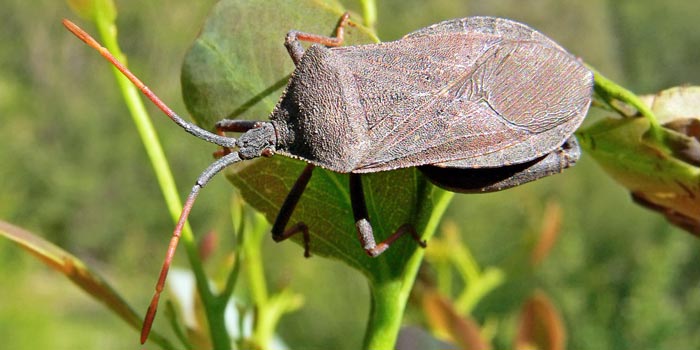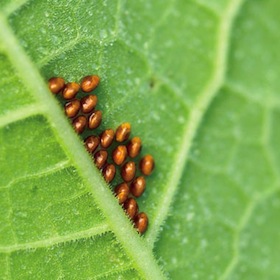 A squash bug is a noxious garden pest, and as the name implies, it goes after squashes and gourds of all types! While most people reach for the chemicals as soon as these pest insects appear, it is also possible to get rid of them in natural ways.
A squash bug is a noxious garden pest, and as the name implies, it goes after squashes and gourds of all types! While most people reach for the chemicals as soon as these pest insects appear, it is also possible to get rid of them in natural ways.
When you are looking at how to kill squash bugs, take a few moments to consider these natural methods before you start reaching for the pesticides. Killing these insects organically takes a little more time and a little more effort, but it can absolutely be done.
Identifying Squash Bug Eggs
The best way to prevent a squash bug infestation is to stop it before it starts. In the early spring, inspect your squash leaves carefully. Squash bug eggs are small, oval in shape and copper-colored. When you see them, wipe them off of the leaf with a cloth and dispose of them. Then use a gentle garden soap to disinfect the area.
If you can get rid of most squash bug eggs before summer, you will be in great shape! Similarly, remember that checking for these eggs will also help you keep an eye out for the odd adult that may be wandering in. Hopefully, you can kill it before it starts producing young.
 Handpicking the Adult Squash Bugs
Handpicking the Adult Squash Bugs
If the infestation is relatively small and it has not spread very far yet, you may simply start by handpicking the adults, nymphs and larvae that you find off of the plant and killing them. Pay special attention to leaves that hang near the ground, where these insects often group together. Do not ignore dead leaves, either, as oftentimes nymphs will end up hiding there until their carapaces are hard enough to survive more adventurous wanderings.
Remember that while thorough handpicking feels very slow, you are still making a difference. Most experts recommend simply handpicking squash bugs off of plants if you have a fairly small crop. The important thing is to be consistent. Handpick every day or every other day if you can.
Diatomaceous Earth Works Wonders with Squash Bugs
Diatomaceous earth is a gardening and pest control product that is used in many different situations. It is harmless to humans, and many varieties are even labeled as food-grade, meaning that it is perfect for scattering around your food plants. Though diatomaceous earth looks like normal dust, it is in fact quite sharp on a microscopic level. When insects brush against it, the sharp edges of the earth tear holes in the insects’ shells, something that is invariably fatal. This is a safe way to start your squash bug control, but it is often best when combined with other methods.
Trap Board to the Rescue
Another technique you might consider is to set a trap board. At night, many squash bugs scuttle for shelter close to the ground and underneath flat objects like wood or leaves. In the evening, lay a board down close to your squash plants. Early in the morning, pull the board up and you will find lots of squash bugs clinging to the board’s underside. At this point, they can be captured and killed at your leisure.
Cedar Tea Keeps Squash Bugs Away
Cedar wood is imbued with aromatic oils that are harmful to insects. This is why cedar chests are so common when it comes to keeping moths out of clothes. If you have a few cedar chips on hand, toss them into a kettle of water and boil them for about fifteen minutes. Remove the cedar chips, and after the mixture has cooled, pour it into a spray bottle and spray the affected plants.
Guardian Plants to the Rescue
When you are fighting a garden pest as stubborn as the squash bug, take a few moments to consider how a few guardian plants might help. While the squash bug loves squash plants, it has a difficult time dealing with the odor of gardenias and nasturtiums. Plant these crops right next to your squash plants, and you will discover that your squash bug problems grow less and less with each passing day.
Green Light Neem
Green Light Neem is a mixture that is 70% neem oil, and as such, it is appropriate for organic gardening. This product is easily found in most gardening stores, and the process is very simple.
A few spoonfuls of the neem is diluted in water and mixed thoroughly. Then the mixture can be poured into a bottle and sprayed over all of the affected plants. Pay careful attention to the instructions that tell you how often to spray.
One of the best things about neem oil is that it is effective on insects at all stages of their life. It kills eggs, nymphs, and adults, so you won’t have to worry about leaving the next generation around to repopulate.
Plant a Trap Crop
If you have been suffering with squash bugs all season and you just want to make sure that you do not have to worry about squash bugs again the next season, it is worth considering a trap crop. Essentially, after you are done harvesting everything, leave one or two squash plants alone in the center of the garden, clearing everything else away. This means that the squash bugs will convene in that small area. After waiting a few days to pick up all of the stragglers, destroy the plants and the insects with them. In an area where this is legal, you may even consider burning the trap plants.
Apply a Garlic and Onion Soil Treatment
Another thing to remember is that squash bugs can be killed in the soil as well as on the plant itself. When you want to treat the soil itself, you will need a bowl of water, a small onion and about six cloves of garlic.
Peel and dice the onion and toss it into the bowl of water. Peel the garlic and dice it as well, adding it to the water. Let the mixture sit overnight. In the morning, the scent should be quite strong. Remove the bits of garlic and onion, and pour the mixture into a spray bottle. Spray the soil around the base of the affected plants. Be careful not to accidentally tag the leaves as you do so, as this mixture can actually burn your plants.
When you are looking to keep your garden healthy organically, these pest insects can really challenge your resolve. Before you reach for the chemical insecticides, however, you will find that there are plenty of options available for you. Just take a moment to consider which options are going to suit you, your lifestyle and the time you have available!

Another remedy for squash bugs. Use a small battery operated hand vacuum on squash bugs,the baby bugs and eggs . (our hand vac came with a tool pack that has a drill, saw etc that operate on rechargable batteries.) Good for other bugs, too. We had Harlequin bugs on kale and vacuumed them away.
Hi!
Nice article , but the bug in thee image is not a squash bug – that image shows a sirilanka weevil.
Best Regards,
Mike
Spraying with soapy water (I used a teaspoon of Dawn in a quart of water) kills them immediately. You may need to do each day, and I still have to see how well it works, really. Thanks for the idea!! So pleased to not have to apply a more expensive and toxic pesticide.